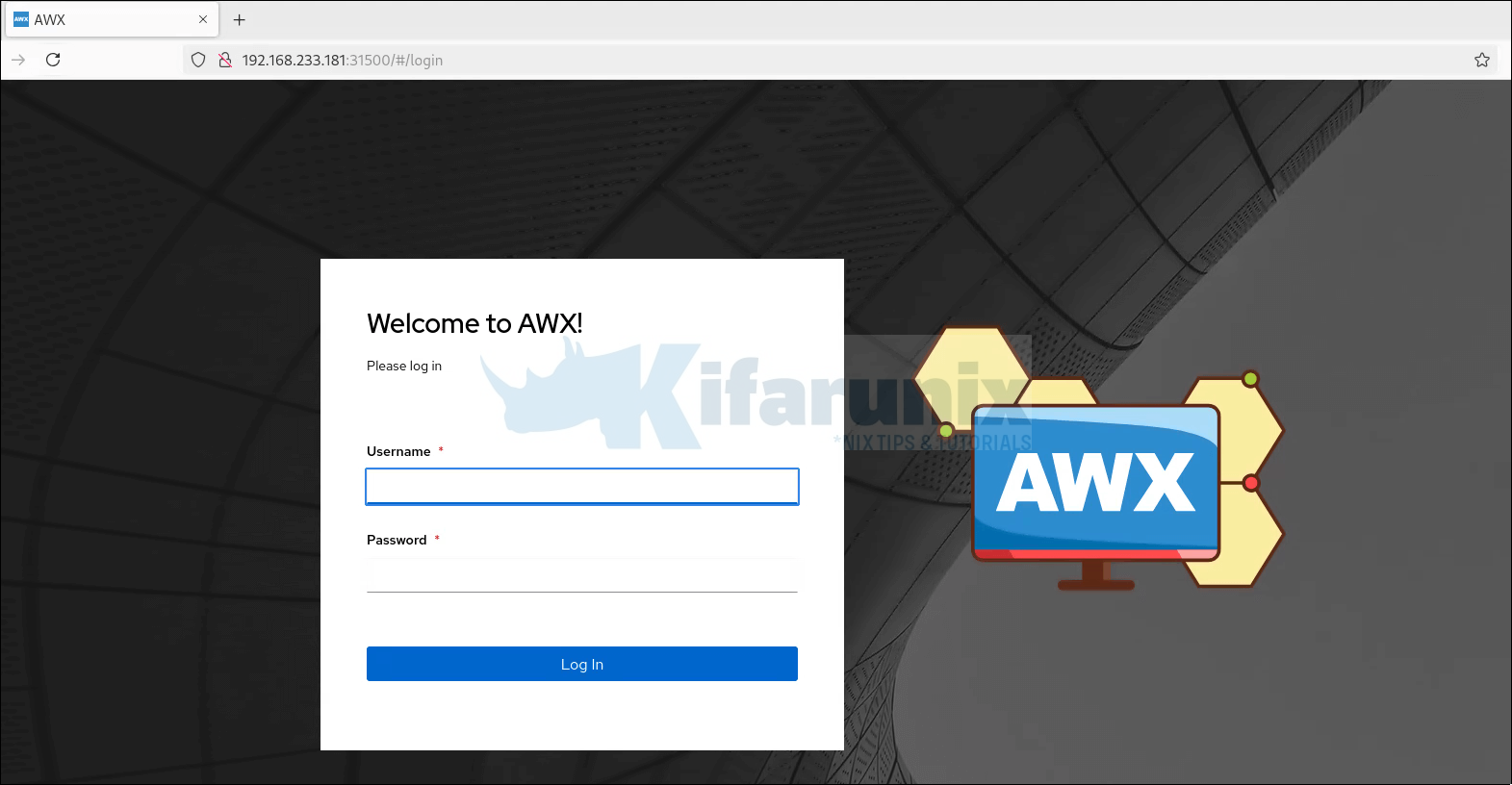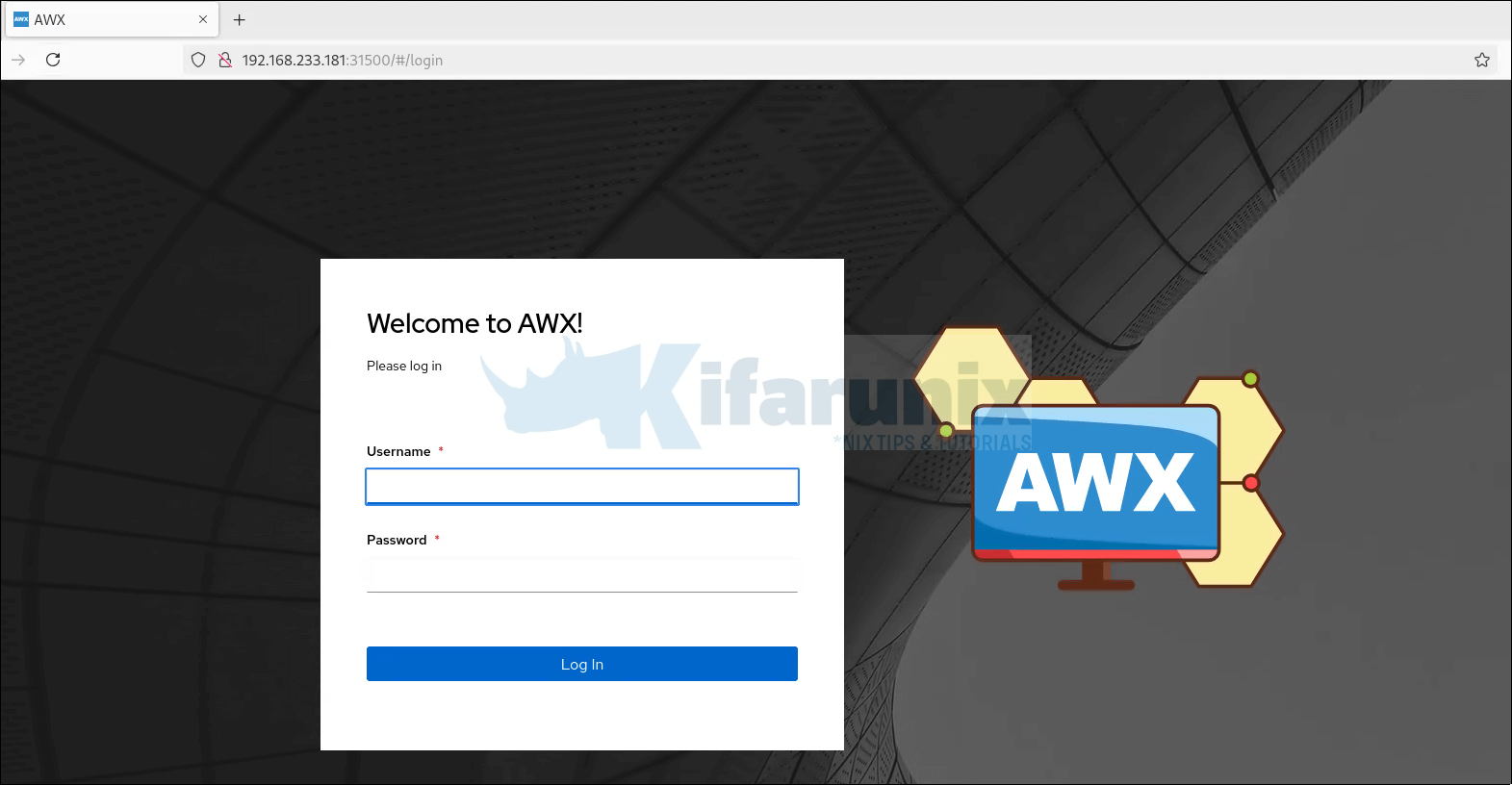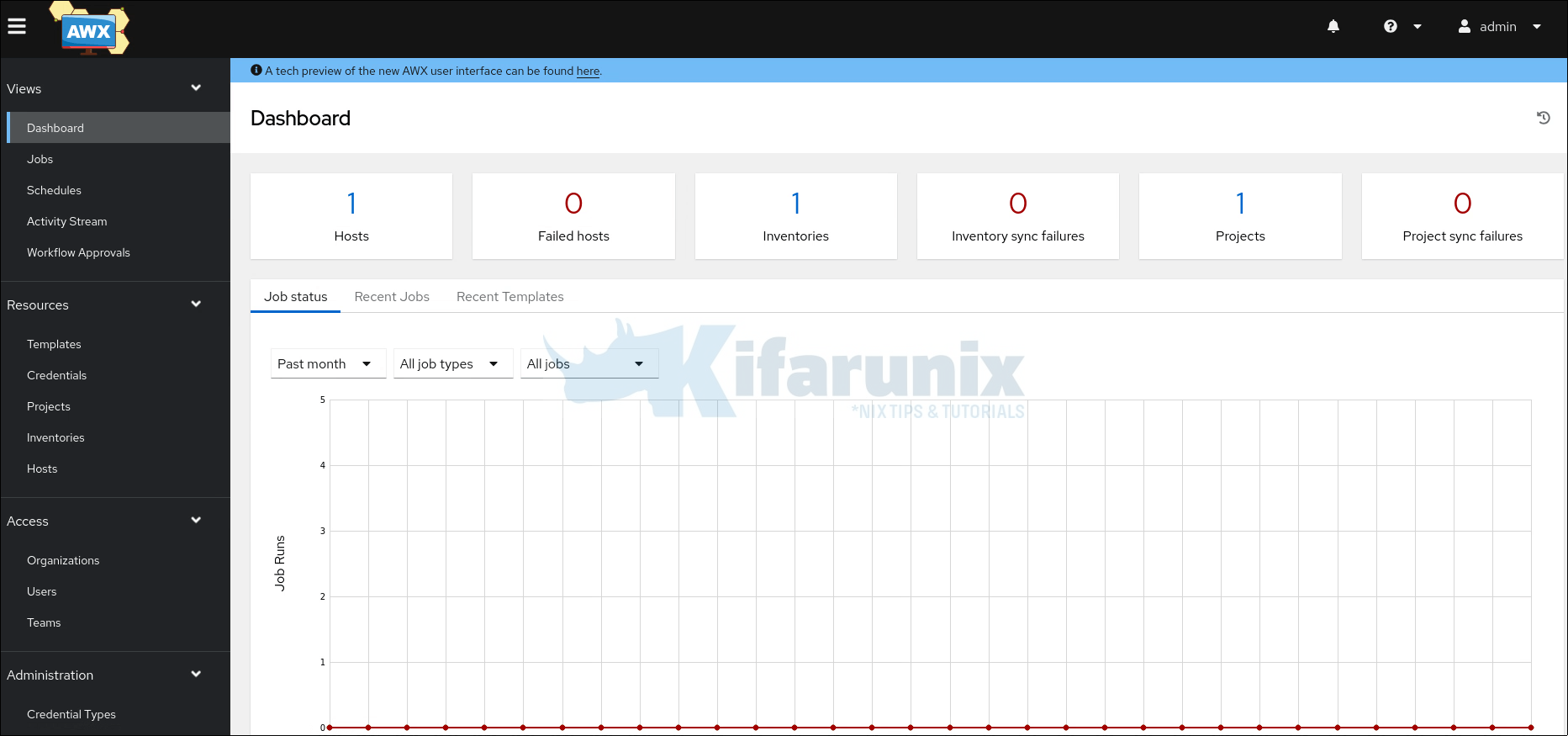
In this guide, you will learn how to easily deploy AWX on Kubernetes cluster using AWX Operator. AWX is an opensource Ansible project which provides a web-based user interface, REST API and a task engine for Ansible. It serves as the upstream project from which the automation controller (formerly Ansible Tower) component in Red Hat Ansible Automation Platform is ultimately derived. AWX Operator on the other hand, is a Kubernetes operator that provides an efficient way to install, configure, and manage the lifecycle of AWX on a Kubernetes cluster or OpenShift environment.
Table of Contents
Deploy AWX on Kubernetes Cluster using AWX Operator
Use of AWX Operator is the current recommended way to deploy AWX on Kubernetes cluster or on OpenShift cluster.
To deploy AWX on Kubernetes cluster using AWX operator, proceed as follows.
Setup Kubernetes Cluster
Before you can proceed, you need to have a Kubernetes cluster (or OpenShift, if you are using it) up and running.
In our previous guides, we are have extensively covered how to deploy single master or multi-master Kubernetes cluster.
Check the links below for more details;
Install and Setup Kubernetes Cluster on RHEL 9
Setup Kubernetes cluster on Ubuntu
In our current cluster, we are running a single master-3 worker node kubeadm Kubernetes cluster.
kubectl get nodesNAME STATUS ROLES AGE VERSION
k8s-rhel-node-ms-01 Ready control-plane 3h15m v1.32.1
k8s-rhel-node-wk-01 Ready <none> 157m v1.32.1
k8s-rhel-node-wk-02 Ready <none> 155m v1.32.1
k8s-rhel-node-wk-03 Ready <none> 155m v1.32.1
You can use Minikube if you want.
Deploy AWX Operator on Kubernetes cluster
Once the Kubernetes cluster is up and running, proceed to deploy the AWX Operator.
Create AWX Operator Namespace
The default namespace for AWX Operator is typically awx. Since we are taking a different installation approach of setting up SC, PV and PVC before deploying AWX operator, let’s begin by creating the namespace.
kubectl create namespace awxEnsure Database Data Persistence via Persistent Volumes
As might already know, AWX uses PostgreSQL as its database backend to store its data, including information about job runs, inventories, users, credentials, and other AWX-related configurations. AWX deployments include an embedded PostgreSQL database, which is deployed alongside AWX.
Therefore, if you want to make sure that the database data persists beyond pod restarts, you can use Persistent Volumes (PVs) to store the database data.
For the purposes of this demo, we will use local filesystem storage to provision our AWX database PV. Essentially, to create a PV:
- Define your storage backend using StorageClass
- Create a PV that defines the actual storage space that Kubernetes can use to persist data for the app.
- Create a PVC to request for specific size of storage from a PV (if a PV matching the request needs is available) or directly from the StorageClass if no matching PV.
1. Create StorageClass
There are different storage provisioners that you can configure for use by AWX operator. However, since we are a local on-premise Kubernetes cluster, we will use local StorageClass provisioner. Local StorageClass provisioner is not usually recommended for production environments though!
Thus, create a manifest to define the local storageclass provisioner.
vim ~/local-storageclass.yamlPaste the content below. You can change the metadata name as you so wish.
apiVersion: storage.k8s.io/v1
kind: StorageClass
metadata:
name: local-storage
provisioner: kubernetes.io/no-provisioner
volumeBindingMode: WaitForFirstConsumer
Create the StorageClass;
kubectl apply -f ~/local-storageclass.yamlYou can check the status of the StorageClass;
kubectl get sc -n awxNAME PROVISIONER RECLAIMPOLICY VOLUMEBINDINGMODE ALLOWVOLUMEEXPANSION AGE
local-storage kubernetes.io/no-provisioner Delete WaitForFirstConsumer false 7s
2. Create AWX Operator Storage Persistent Volume
Now that you have defined the type of StorageClass to be used, proceed to define the actual storage resource on for AWX on Kubernetes (Persistent Volume, PV).
We have three worker nodes in our cluster:
kubectl get nodesNAME STATUS ROLES AGE VERSION
k8s-rhel-node-ms-01 Ready control-plane 14h v1.32.1
k8s-rhel-node-wk-01 Ready <none> 13h v1.32.1
k8s-rhel-node-wk-02 Ready <none> 13h v1.32.1
k8s-rhel-node-wk-03 Ready <none> 13h v1.32.1
and as such, we will create a PV bound to each one of them so that any pod scheduled on each node, will use a PV defined on the same node. This is just so as to ensure there is no data corruption resulting from multiple pods on different nodes writing to the same storage.
vim ~/awx-pv.yamlThe contents of the file;
apiVersion: v1
kind: PersistentVolume
metadata:
name: awx-pg-wk-01-pv
spec:
capacity:
storage: 10Gi
volumeMode: Filesystem
accessModes:
- ReadWriteOnce
persistentVolumeReclaimPolicy: Retain
storageClassName: local-storage
local:
path: /mnt/k8s/awx/pg/
nodeAffinity:
required:
nodeSelectorTerms:
- matchExpressions:
- key: kubernetes.io/hostname
operator: In
values:
- k8s-rhel-node-wk-01
---
apiVersion: v1
kind: PersistentVolume
metadata:
name: awx-pg-wk-02-pv
spec:
capacity:
storage: 10Gi
volumeMode: Filesystem
accessModes:
- ReadWriteOnce
persistentVolumeReclaimPolicy: Retain
storageClassName: local-storage
local:
path: /mnt/k8s/awx/pg/
nodeAffinity:
required:
nodeSelectorTerms:
- matchExpressions:
- key: kubernetes.io/hostname
operator: In
values:
- k8s-rhel-node-wk-02
---
apiVersion: v1
kind: PersistentVolume
metadata:
name: awx-pg-wk-03-pv
spec:
capacity:
storage: 10Gi
volumeMode: Filesystem
accessModes:
- ReadWriteOnce
persistentVolumeReclaimPolicy: Retain
storageClassName: local-storage
local:
path: /mnt/k8s/awx/pg/
nodeAffinity:
required:
nodeSelectorTerms:
- matchExpressions:
- key: kubernetes.io/hostname
operator: In
values:
- k8s-rhel-node-wk-03
As a summary, this YAML file defines three PersistentVolumes (PVs) for AWX PostgreSQL data storage in a Kubernetes environment. Each volume is configured with the following key points:
- Storage Class: Uses the
local-storageclass created before for local disk provisioning. - Capacity: 10Gi per volume.
- Reclaim Policy:
Retain(the PV will not be deleted when the PVC is removed). - Node Affinity: Each PV is restricted to a specific node (
k8s-rhel-node-wk-01,k8s-rhel-node-wk-02, andk8s-rhel-node-wk-03). The local storage path,/mnt/k8s/awx/pg/, must already be existing on the node before this PV is used.
So, let’s create the storage path on each worker node.
sudo mkdir -p /mnt/k8s/awx/pg$ getenforce
Permissive
Apply the YAML file to create the PV.
kubectl apply -f ~/awx-pv.yamlConfirm the PV creation.
kubectl get pv -n awxNAME CAPACITY ACCESS MODES RECLAIM POLICY STATUS CLAIM STORAGECLASS VOLUMEATTRIBUTESCLASS REASON AGE
awx-pg-wk-01-pv 10Gi RWO Retain Available local-storage <unset> 10s
awx-pg-wk-02-pv 10Gi RWO Retain Available local-storage <unset> 10s
awx-pg-wk-03-pv 10Gi RWO Retain Available local-storage <unset> 10s
3. Create Persistent Volume Claim for AWX PostgreSQL DB
Next, create the PVC for the AWX PostgreSQL database. By default, AWX operator uses a PVC configured as follows;
apiVersion: v1
kind: PersistentVolumeClaim
metadata:
creationTimestamp: "2025-01-19T11:19:17Z"
finalizers:
- kubernetes.io/pvc-protection
labels:
app.kubernetes.io/component: database
app.kubernetes.io/instance: postgres-15-awx-demo
app.kubernetes.io/managed-by: awx-operator
app.kubernetes.io/name: postgres-15
name: postgres-15-awx-demo-postgres-15-0
namespace: awx
resourceVersion: "37082"
uid: c07fa7f4-ed6b-4d83-bb6d-b820fd1143d4
spec:
accessModes:
- ReadWriteOnce
resources:
requests:
storage: 8Gi
volumeMode: Filesystem
status:
phase: Pending
We will just modify this PVC to use our StorageClass and PV. Here is a modified version.
vim ~/awx-pvc.yamlapiVersion: v1
kind: PersistentVolumeClaim
metadata:
finalizers:
- kubernetes.io/pvc-protection
labels:
app.kubernetes.io/component: database
app.kubernetes.io/instance: postgres-15-awx-demo
app.kubernetes.io/managed-by: awx-operator
app.kubernetes.io/name: postgres-15
name: postgres-15-awx-demo-postgres-15-0
namespace: awx
spec:
accessModes:
- ReadWriteOnce
resources:
requests:
storage: 10Gi
storageClassName: local-storage
volumeMode: Filesystem
Create the AWX PostgreSQL PVC;
kubectl apply -f ~/awx-pvc.yamlConfirm;
kubectl get pvc -n awxNAME STATUS VOLUME CAPACITY ACCESS MODES STORAGECLASS VOLUMEATTRIBUTESCLASS AGE
postgres-15-awx-demo-postgres-15-0 Pending local-storage <unset> 61s
As you can see, it is not bound yet since there is no request for storage has been issues yet.
Accessing AWX Projects from the Host Level
To be able to access the projects directory (where Ansible playbooks and related files are stored), /var/lib/awx/projects/, from the host level, you need to ensure that this directory is also backed by a Persistent Volume (PV) which can be accessed from the host file system. We will use an NFS share for this.
Configure Persistent Volume for Projects Directory via NFS share:
We already have an NFS share, /mnt/awx/projects, to use for our AWX projects PV.
Let’s create a PV and PVC manifest.
vim ~/awx-projects-pv.yamlapiVersion: v1
kind: PersistentVolume
metadata:
name: awx-projects-pv
spec:
accessModes:
- ReadWriteMany
capacity:
storage: 2Gi
storageClassName: ""
persistentVolumeReclaimPolicy: Retain
nfs:
path: /mnt/awx/projects
server: 192.168.233.181
---
apiVersion: v1
kind: PersistentVolumeClaim
metadata:
name: awx-projects-pvc
namespace: awx
spec:
accessModes:
- ReadWriteMany
resources:
requests:
storage: 2Gi
Apply the manifest to create the PV and PVC for AWX projects.
kubectl apply -f ~/awx-projects-pv.yamlSo, we now have PV for database and projects;
kubectl get pv,pvc -n awxNAME CAPACITY ACCESS MODES RECLAIM POLICY STATUS CLAIM STORAGECLASS VOLUMEATTRIBUTESCLASS REASON AGE
persistentvolume/awx-pg-wk-01-pv 10Gi RWO Retain Available local-storage <unset> 7m22s
persistentvolume/awx-pg-wk-02-pv 10Gi RWO Retain Available local-storage <unset> 7m22s
persistentvolume/awx-pg-wk-03-pv 10Gi RWO Retain Available local-storage <unset> 7m22s
persistentvolume/awx-projects-pv 2Gi RWX Retain Bound awx/awx-projects-pvc <unset> 4m19s
NAME STATUS VOLUME CAPACITY ACCESS MODES STORAGECLASS VOLUMEATTRIBUTESCLASS AGE
persistentvolumeclaim/awx-projects-pvc Bound awx-projects-pv 2Gi RWX <unset> 2m49s
persistentvolumeclaim/postgres-15-awx-demo-postgres-15-0 Pending local-storage <unset> 5m9s
Deploy AWX Operator
While you can clone the AWX operator repository and deploy it on from the repository directory on your system, you can also use a Kustomization file instead. Since we need to kustomize our deployment with custom StorageClass as well as PV/PVC created above, we will use the Kustomization route.
Here is a sample Kustomization file contents;
apiVersion: kustomize.config.k8s.io/v1beta1
kind: Kustomization
resources:
# Find the latest tag here: https://github.com/ansible/awx-operator/releases
- github.com/ansible/awx-operator/config/default?ref=<tag>
# Set the image tags to match the git version from above
images:
- name: quay.io/ansible/awx-operator
newTag: <tag>
# Specify a custom namespace in which to install AWX
namespace: awx
As such, let’s create a directory from where will create our AWX operator kustomization file.
mkdir awxNavigate into the directory and create a Kustomization file.
cd awxvim kustomization.yamlPaste the contents below;
apiVersion: kustomize.config.k8s.io/v1beta1
kind: Kustomization
namespace: awx
resources:
# Find the latest tag here: https://github.com/ansible/awx-operator/releases
- github.com/ansible/awx-operator/config/default?ref=2.19.1
# Set the image tags to match the git version from above
images:
- name: quay.io/ansible/awx-operator
newTag: 2.19.1
So deploy the AWX operator first so that the necessary CRDs and other configs are created before you can customize it.
kubectl apply -k .At a high level summary, this is what happens:
- Configuration the AWX namespace for organizing resources.
- Defining Custom Resources (CRDs) for AWX-related components like backups, restores, and mesh ingress.
- Setting up service accounts and RBAC roles to manage permissions for the AWX operator.
- Configuring services and deployments for the AWX operator to run and expose necessary metrics.
Next, we can customize the AWX deployment to define the persistent storage for Database and projects. Below is our manifest to make these updates.
cat awx-configs.yamlapiVersion: awx.ansible.com/v1beta1
kind: AWX
metadata:
name: awx-demo
namespace: awx
spec:
service_type: nodeport
nodeport_port: 31500 # You can remove to assign random port or change to you preference
ingress_type: none
projects_persistence: true
projects_existing_claim: awx-projects-pvc
postgres_init_container_resource_requirements: {}
postgres_data_volume_init: true
postgres_storage_class: local-storage
postgres_init_container_commands: |
chown -R 26:26 /var/lib/pgsql/data
Update the file accordingly.
Refer to the documentation for more explanation on the configuration parameters used.
To apply these changes, edit the kustomization file and include this manifest under the resources section.
cat kustomization.yamlapiVersion: kustomize.config.k8s.io/v1beta1
kind: Kustomization
namespace: awx
resources:
# Find the latest tag here: https://github.com/ansible/awx-operator/releases
- github.com/ansible/awx-operator/config/default?ref=2.19.1
- awx-configs.yaml
# Set the image tags to match the git version from above
images:
- name: quay.io/ansible/awx-operator
newTag: 2.19.1
Apply the Kustomization to deploy AWX operator on Kubernetes cluster.
kubectl apply -k .It will take a while before the AWX operator and other services is up and running.
You can list all resources created in the awx namespace as follows;
kubectl get all -n awxYou can also watch the pods;
kubectl get pods -n awx -wNAME READY STATUS RESTARTS AGE
awx-demo-postgres-15-0 1/1 Running 0 117s
awx-demo-task-5d5b6b856b-lhdlx 0/4 Init:0/3 0 91s
awx-demo-web-7cb57bb787-h846q 3/3 Running 0 92s
awx-operator-controller-manager-58b7c97f4b-9h8fm 2/2 Running 0 3m22s
Or watch the events;
kubectl get events -n awx -wIt will take a while before the AWX is ready.
Sample events:
0s Normal Scheduled pod/awx-demo-migration-24.6.1-kdtmp Successfully assigned awx/awx-demo-migration-24.6.1-kdtmp to k8s-rhel-node-wk-02
0s Normal Pulled pod/awx-demo-migration-24.6.1-kdtmp Container image "quay.io/ansible/awx:24.6.1" already present on machine
0s Normal Created pod/awx-demo-migration-24.6.1-kdtmp Created container: migration-job
0s Normal Started pod/awx-demo-migration-24.6.1-kdtmp Started container migration-job
0s Normal Completed job/awx-demo-migration-24.6.1 Job completed
0s Normal Pulling pod/awx-demo-task-77ddf68cf8-snzkh Pulling image "quay.io/ansible/awx-ee:24.6.1"
0s Normal Pulled pod/awx-demo-task-77ddf68cf8-snzkh Successfully pulled image "quay.io/ansible/awx-ee:24.6.1" in 26.016s (26.016s including waiting). Image size: 468650745 bytes.
0s Normal Created pod/awx-demo-task-77ddf68cf8-snzkh Created container: init-receptor
0s Normal Started pod/awx-demo-task-77ddf68cf8-snzkh Started container init-receptor
0s Normal Pulling pod/awx-demo-task-77ddf68cf8-snzkh Pulling image "quay.io/centos/centos:stream9"
0s Normal Pulled pod/awx-demo-task-77ddf68cf8-snzkh Successfully pulled image "quay.io/centos/centos:stream9" in 1.897s (1.897s including waiting). Image size: 60726367 bytes.
0s Normal Created pod/awx-demo-task-77ddf68cf8-snzkh Created container: init-projects
0s Normal Started pod/awx-demo-task-77ddf68cf8-snzkh Started container init-projects
0s Normal Pulling pod/awx-demo-task-77ddf68cf8-snzkh Pulling image "docker.io/redis:7"
0s Normal Pulled pod/awx-demo-task-77ddf68cf8-snzkh Successfully pulled image "docker.io/redis:7" in 4.069s (4.069s including waiting). Image size: 45006722 bytes.
0s Normal Created pod/awx-demo-task-77ddf68cf8-snzkh Created container: redis
0s Normal Started pod/awx-demo-task-77ddf68cf8-snzkh Started container redis
0s Normal Pulled pod/awx-demo-task-77ddf68cf8-snzkh Container image "quay.io/ansible/awx:24.6.1" already present on machine
0s Normal Created pod/awx-demo-task-77ddf68cf8-snzkh Created container: awx-demo-task
0s Normal Started pod/awx-demo-task-77ddf68cf8-snzkh Started container awx-demo-task
0s Normal Pulled pod/awx-demo-task-77ddf68cf8-snzkh Container image "quay.io/ansible/awx-ee:24.6.1" already present on machine
0s Normal Created pod/awx-demo-task-77ddf68cf8-snzkh Created container: awx-demo-ee
0s Normal Started pod/awx-demo-task-77ddf68cf8-snzkh Started container awx-demo-ee
0s Normal Pulled pod/awx-demo-task-77ddf68cf8-snzkh Container image "quay.io/ansible/awx:24.6.1" already present on machine
0s Normal Created pod/awx-demo-task-77ddf68cf8-snzkh Created container: awx-demo-rsyslog
0s Normal Started pod/awx-demo-task-77ddf68cf8-snzkh Started container awx-demo-rsyslog
Pods at the end of setup;
kubectl get pod -n awxNAME READY STATUS RESTARTS AGE
awx-demo-migration-24.6.1-kdtmp 0/1 Completed 0 7m25s
awx-demo-postgres-15-0 1/1 Running 0 27m
awx-demo-task-77ddf68cf8-snzkh 4/4 Running 0 24m
awx-demo-web-6f644fc5-vkg7v 3/3 Running 5 (9m18s ago) 24m
awx-operator-controller-manager-58b7c97f4b-ggfjq 2/2 Running 2 (25m ago) 30m
Accessing AWX Web Interface
By now, AWX should be up and running on the Kubernetes cluster.
If you check the available services;
kubectl get svc -n awxNAME TYPE CLUSTER-IP EXTERNAL-IP PORT(S) AGE
awx-demo-postgres-15 ClusterIP None <none> 5432/TCP 47m
awx-demo-service NodePort 10.111.226.182 <none> 80:31500/TCP 44m
awx-operator-controller-manager-metrics-service ClusterIP 10.110.9.218 <none> 8443/TCP 51m
If you see, the web service is exposed via NodePort on port 31500/tcp. This is the port that was defined in the awx-configs.yaml configuration file above. You should be able to access AWX service via the IP of any node in the cluster.
Remember, we are running our Kubernetes cluster on RHEL 9 nodes. And since we are using Calico CNI, we have disabled the firewalld. Hence, the service should be seamlessly accessible.
Access the AWX web interface via http://<any-cluster-node-IP>:NodePort. For example, http://192.168.233.181:31500.

The default username for AWX web is admin. You can extract the login password from the AWX admin password secret.
kubectl get secrets -n awxNAME TYPE DATA AGE
awx-demo-admin-password Opaque 1 17h
awx-demo-app-credentials Opaque 3 17h
awx-demo-broadcast-websocket Opaque 1 17h
awx-demo-postgres-configuration Opaque 6 17h
awx-demo-receptor-ca kubernetes.io/tls 2 17h
awx-demo-receptor-work-signing Opaque 2 17h
awx-demo-secret-key Opaque 1 17h
redhat-operators-pull-secret Opaque 1 17h
Check the password fields;
kubectl get secret awx-demo-admin-password -n awx -o json{
"apiVersion": "v1",
"data": {
"password": "U29lV1h5cndNNEtuTWcyWHZuS1RjWm5hSXZtZHhpZUk="
},
"kind": "Secret",
"metadata": {
"annotations": {
...
The secret values are usually Base64 encoded. Extract and decode.
kubectl get secret awx-demo-admin-password -n awx -o jsonpath='{.data.password}' | base64 --decode; echoThe resulting string should be your password. Use it to login to AWX web as user admin.

And that is it!
Confirm that the DB data is available on worker nodes Filesystem. You can do this by checking where the Pod is currently running and checking the presence of data on the respective node filesystem path
kubectl get pod awx-demo-postgres-15-0 -o wide -n awxFor the AWX projects, you can validate by navigating to the AWX web dashboard, head over to projects. You will see Demo project. Click the Sync button to sync the project data to the underlying storage. In this case, our storage path is an NFS share.

You should then be able to see project files;
ll /mnt/awx/projects/ ll /mnt/awx/projects/
total 0
drwxr-xr-x. 3 kifarunix root 58 Jan 23 08:57 _6__demo_project
-rwxr-xr-x. 1 kifarunix root 0 Jan 23 08:57 _6__demo_project.lock
So, you can as well start creating your projects here and sync them to AWX.
That marks the end of this tutorial on how to deploy AWX on Kubernetes cluster using AWX Operator.

